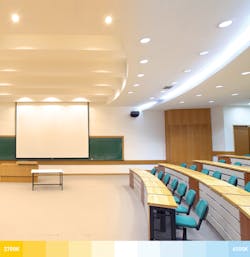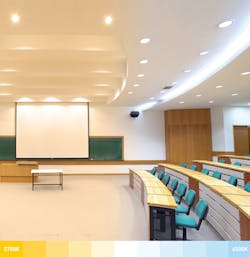The key to prioritizing human-centric lighting in commercial projects is understanding the controllability that it affords, writes CHARLES KNUFFKE.
But what if we could add a new axis of innovation to the work environment? What if in addition to improving the tools in our spaces, we could also improve the productivity of workers and at the same time increase efficiency?
In terms of lighting, we can improve the workplace experience by thinking about building design in an entirely new way. There are emotions associated with buildings, and many of these emotions are conjured from the effects of lighting on people. A dark, poorly lit space is sterile and cold. The hum and slight flickering of old fluorescent lamps is corrosive to concentration and therefore performance. The best spaces, where lighting works with the environment, evoke positive emotions of happiness, healthiness, and energy.
The advent of LED lighting has provided more consistent and positively scalable lighting outcomes. LEDs offer huge energy savings, flexibility, and reliability, and are now entering nearly every application in the built environment.
For more than 50 years, dimming technology has been available for commercial spaces, although previously it was considered prohibitively expensive for most general lighting applications. Light levels were altered by directly adjusting the fixture's electrical power circuit. And while there are LED lamps that can be managed with the previous generation of controls, the future lies in embedding the control capability into the LED's driver and using digital protocols that communicate to the driver directly.
The new vision on how to maximize the value of LED lighting is to not only adjust the intensity of the light, but also the color quality — comprising correlated color temperature (CCT) and color rendering. By controlling both the intensity and the color of the light, the lighting design can provide an additional improvement in occupant satisfaction and productivity.
Human-centric lighting at work
Using tunable LEDs in this manner is known as human-centric lighting (HCL), and it offers many potential advantages in offices and workspaces. Research is underway into the potential emotional and biological outcomes of lighting that mimics the changes in color temperatures found in natural daylight. (see "Speakers cover circadian disruption to healthcare assessment at new conference" for details on the latest scientific findings presented at the Lighting for Health and Wellbeing Conference.)
What is known for certain right now is HCL has visual benefits that increase the value for the occupants in the environments where the luminaires are installed. The lighting refines the space, alters how architecture is perceived, and creates tangible ways of providing more comfortable and customizable atmospheres within buildings.
Healthcare facilities are using HCL to add cooler CCTs in staff areas to keep employees alert during shifts, while also using warmer CCTs in patient rooms to keep individuals comfortable as they rest and recover. Schools utilize HCL to both calm students and to keep them alert depending on the time of day. And in commercial workplaces, the effects of appropriate lighting CCT can make the office environment feel more natural and comfortable while improving productivity and retention (see "Human-centric lighting takes hold in the commercial workplace" for examples of commercial HCL projects).
The effort to keep workers healthy, engaged, and attentive is a cause rooted in very real financial outcomes. And just as ergonomic chairs and keyboards, on-site health centers, and standing desks have helped businesses to have happier, healthier employees, HCL offers an additional opportunity to improve worker outcomes.
The next steps in lighting control
To bring HCL into a building means installing both tunable fixtures and smart lighting controls that can drive intensity and CCT. One innovative technology that can be implemented into these controls is a scheduling device (whether local to the room, or as an element of the building's overall lighting control system) that automatically synchronizes a building's lighting cycle through astronomically-based event times. That means a building can match the exact lighting conditions outside the building dependent on the precise latitude and longitude of the location. Of course, this setting can be overridden or customized. The important takeaway is an intelligent HCL system can manage itself in the background, so facilities managers don't need to make daily adjustments to allow the system to perform and offer the full benefits of quality light.
The HCL system is also not a standalone system. Rather, it is another dimension in the broader lighting control system that utilizes occupancy sensors and photocells to automatically adjust light levels and conserve energy.
For those considering adding HCL as a potential offering, there are a few things to be aware of in the current ecosystem of products.
Enabled fixtures must work with the lighting control system without adding any complexity. Not all manufacturers have made this available, and users won't be happy being stuck with an advanced, HCL-enabled fixture with no way of controlling it, or with systems that are more complex because of the new color control capability. This means providing a light engine and control system that have been co-developed and created with end users in mind — that's critical.
Furthermore, the installation and programming can be complex — and costly — with some types of HCL systems. Custom software can be required from the control manufacturer to achieve CCT results. Also, most contractors you may work with are probably not as familiar with digital lighting protocols such as DALI (digital addressable lighting interface) or DMX controls used with tunable fixtures.
The future is tunable
The reality is that tunable light will soon become as common as dimming. The reality is that all light is not created equal. Just as with other products or technologies, there are varying degrees of quality. People will begin to encounter HCL more, and they will soon come to expect it in the spaces where they spend prolonged amounts of time.
That means new construction will soon demand this option in the design and specification stage. Also, retrofit opportunities must be available to existing buildings.
The end goal for a facility's lighting, new or old, should be that it fades into the background in such a way that the built environment feels just as visually comfortable as the lighting in our natural environments — with abilities to simulate the daily transitions outside within the indoor space. And in the moments where manual adjustment is needed, the system can be optimized and altered to suit the specific task at hand.
CHARLES KNUFFKE is the Wattstopper Systems vice president and evangelist at Legrand.







